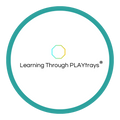What Are Play Schemas? Understanding Your Child’s Urges to Learn

Table of contents
Understanding Schemas in Early Childhood: What Are They and Why Do They Matter?
Have you ever watched a child repeatedly drop their toy from the high chair? Or carefully line up all their cars in a straight line? Maybe they’ve climbed inside a cardboard box for the tenth time today? These aren't just random behaviors — they’re called schemas .

What Are Schemas in Early Childhood?
Schemas are repeated patterns of behavior that children naturally follow as they learn how the world works. These behaviors come from deep within — they’re natural, developmental urges that help children understand concepts like movement, space, shape, transformation, and more.
Understanding schemas helps parents and educators:
Recognize behaviors as part of healthy development.
Support children's learning by setting up environments that match their current interests.
Respond with patience and curiosity instead of frustration.
Now, let’s explore the 9 most common schemas — and what they might look like in everyday play.



9 Most Common Schemas

1. Trajectory Schema
Children in the trajectory schema are fascinated by how things move — especially in straight or curved lines.
You might see:
Throwing food, toys, or balls.
Pushing toy cars down ramps.
Running back and forth across the room.
How to support it:
Offer paper airplanes, ramps, and scarves to toss.
Set up safe throwing zones or water squirters.

2. Enclosure/Containing Schema
This schema is all about putting things inside other things — and sometimes putting themselves inside too.
You might see:
Hiding inside boxes or under tables.
Filling bags, baskets, or containers with toys.
Drawing circles or enclosing shapes with blocks.
How to support it:
Use nesting cups, empty cardboard boxes, or baskets.
Try sensory bins or water play with containers.

3. Enveloping Schema
Children love to cover themselves or objects completely.
You might see:
Wrapping toys in fabric, paper, or tape.
Hiding under blankets or dressing in layers.
Painting over drawings until they’re totally covered.
How to support it:
Provide scarves, wrapping paper, or play silks.
Offer foil or paper for wrapping and unwrapping.

4. Transporting Schema
Kids are drawn to moving things from one place to another — over and over again.
You might see:
Filling up bags or buckets and moving them across the room.
Carrying blocks or toys from one corner to another.
Moving pebbles, sand, or water from one container to the next.
How to support it:
Offer carts, baskets, or wheelbarrows.
Try a nature walk with a collection bag.

5. Positioning Schema
Children are focused on organizing, lining up, and placing objects precisely.
You might see:
Lining up cars, animals, or blocks.
Placing stickers or objects in perfect rows.
Arranging items by color or size.
How to support it:
Try sorting games or pattern cards.
Use magnetic tiles or shape sorters.

6. Rotation Schema
Children are interested in things that turn or spin.
You might see:
Fascination with wheels, fans, or spinning toys.
Twirling themselves around.
Drawing spirals or circles.
How to support it:
Offer tops, pinwheels, or lazy Susans.
Dance with ribbons or scarves.

7. Connecting Schema
Kids want to join things together — and sometimes take them apart.
You might see:
Building long chains with blocks or train tracks.
Taping or gluing objects together.
Connecting their fingers or body parts in odd ways.
How to support it:
Use blocks, magnets, or links.
Provide string, tape, or Velcro materials.

8. Orientation Schema
Children want to see the world from different angles — even upside down!
You might see:
Hanging upside down off furniture.
Looking between their legs or turning toys around.
Tilting their head when observing something.
How to support it:
Use obstacle courses, mirrors, or climbing frames.
Let them lie down and look at picture books upside down!

9. Transforming Schema
Children want to see how materials change — especially when mixed or altered.
You might see:
Mixing paint, water, or playdough.
Smearing food or mud.
Melting ice or combining materials.
How to support it:
Offer sensory play with water, sand, or baking soda and vinegar.
Let them mix colors or textures in a TUFF tray by Learning Through PLAYtrays or bin.


Why Understanding Schemas Matters
Schemas aren’t just a phase — they’re essential. When we understand them, we shift from asking “Why are they doing that?” to saying “Oh, they’re learning!”
By observing and embracing schemas:
We meet children where they are developmentally.
We reduce frustration and encourage deeper play.
We build environments that reflect children’s true needs.
At Learning Through PLAYtrays® , we believe in supporting schemas with purpose — through thoughtful setups, sensory play, and child-led exploration.


